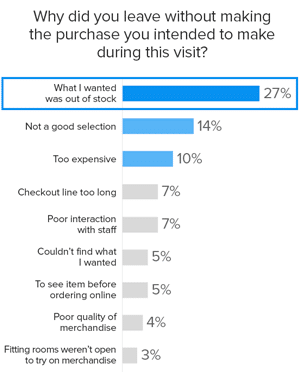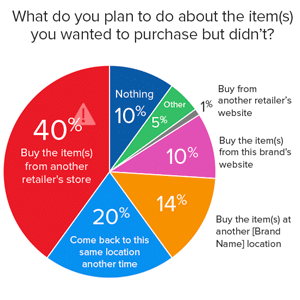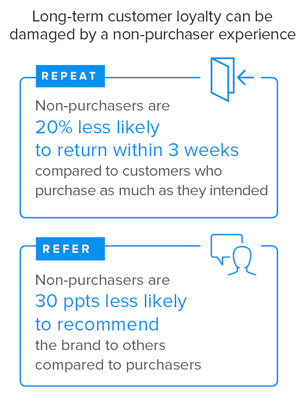How to capture more consumer spend + drive conversion | SMG’s proprietary research identifies behaviors and barriers of non-purchasers
Published on May 19, 2021

As COVID-19 cases continue to decline across the country, more consumers are starting to feel comfortable shopping in-store again. And while e-commerce and digital sales will continue to grow long after the pandemic is over, the current increase in foot traffic is a great opportunity for retailers to provide the kind of experience that entices customers to spend more and come back.
Because while there are many advantages to online shopping, a lot of people still prefer the in-store experience—but only if you have what they’re looking for (or can entice them with something else). Unfortunately, brands are often falling short, with 1 in 10 customers failing to buy what they intended during their in-store visit.
These non-purchasing customers are a huge opportunity for retailers. Losing 10% of potential business has a big financial impact over time. For example, let’s say a brand does 200 million transactions a year with an average spend per customer of $50. The non-purchaser impact would be 20 million missed transactions—resulting in about $1.1 billion in annual revenue loss.
Using feedback collected SMG’s location-based mobile research—we’ve compiled this list of FAQs to identify key reasons consumers don’t make purchases they intended to during a retail visit and provide retailers with actionable ways to prevent or overcome those barriers. Let’s take a look:
Do Consumers Have a Retail Destination in Mind?
Yes—non-purchasers especially. Our research shows almost half of non-purchasers begin their shopping mission with a specific item in mind. They’ve done their research. They’ve planned to visit a particular store and are on the hunt, often needing the item right away.
But despite having every intention of making a purchase, 1 out of 10 customers will leave your store empty-handed—costing you the transaction and hurting your chances of a return visit.
What is the Biggest Barrier to Purchase?
Product availability and selection are the biggest prohibitors to purchase completion. This is true across retail segments. Our research shows 27% of respondents didn’t make a purchase because the item they wanted was out-of-stock. It’s also important to remember that because most non-purchasers have an immediate need, online delivery is not a feasible option for them.

So, what happens when the customer can’t find what they’re looking for and ordering from your website doesn’t work for them? They’re off to one of your competitors. Only 20% of respondents said they’d give you another chance and return at a later time—but 40% will buy the item from another retailer’s store.

How Can Retail Brands Capture More Purchases?
Obviously, the best way to convert a non-purchaser into a paying customer is to provide them with the item they are looking for. But sometimes, being out of stock means being out of stock. This is when your front-line staff can save the day. They can confirm if the item truly isn’t there or if the customer is just having trouble finding it.
Most customers who encounter availability issues seek staff assistance. Having knowledgeable employees that know their way around the store is key. Yes, it’s frustrating for customers when you don’t have what they need, but it’s even more detrimental when what they need is help and they’re not finding it.
Unfortunately, only 2 in 5 customers who seek staff assistance are highly satisfied with the assistance they receive. Ensure your staff is well-trained and has a vast understanding of your products. They can offer alternative suggestions, reroute customers to other options within the store, and potentially save the transaction—and drive long-term loyalty.
Does a Non-Purchasing Experience Create Long-Term Damage?
Yes. The stakes are high when it comes to converting non-purchasers. It’s often not just about the immediate lost transaction—it’s about the effect on future consumer purchasing decisions.
Our study shows non-purchasers were 20% less likely to return to that brand within 3 weeks when compared to customers who purchased as much as they intended. Additionally, non-purchasers were 30 ppts less likely to recommend the brand to others.

2 Ways to Break Down Barriers and Drive Conversion
First, prioritize staff training on customer recovery. Educate employees on what to do when customers have product availability or selection issues. Our data shows customers who interact with staff are more likely to:
- Return to the same location
- Visit a nearby location of the brand
- Use the brand’s buy online, pick-up in store (BOPIS) or curbside options
Second, you need to understand who the non-purchaser is. Reducing non-purchaser customer experiences represent a large revenue opportunity, but this group of customers is difficult to track. Identify ways to learn more about your non-purchaser customer journey and how to recover these customers.
SMG’s ongoing non-purchaser studies are continuously collecting data to help retail brands understand this elusive group of customers. Our propriety research can also be customized to help your brand’s specific research and business goals. Contact us to find out where your company stands among competitors.
Kalli Hannam | Research Manager
Related articles

Expert spotlight with Michael Beesley | How the Engineering VP contributes to SMG’s continued innovation in customer experience management
Learn about the innovative contributions of Michael Beesley, SMG’s VP of Engineering, to customer experience management.

Convenience store traffic: 3 of the latest consumer trends you need to know
Informed by real-world data, these 3 CX convenience store trends map the customer traffic patterns and expectations to know so stores can drive loyalty in 2023.

Experience design for consumer services: From first touch to lasting impact
Experience design is crucial in the consumer services space. Learn how personalization, always-on communities, and proactive strategies drive loyalty, satisfaction, and growth.